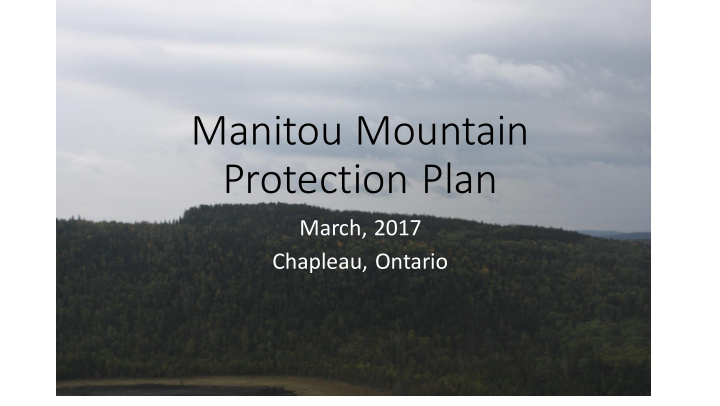



Manitou Mountain Protection Plan March, 2017 Chapleau, Ontario
Introduction • Who we are – First Nations of the Region (NSRCF) • Interests and values - Stewardship of the Land and Resources for future generations • Balanced Approach (Economic, Social, Cultural, Environmental) • Collaborative, Inclusive, Creative • Conservation Economy • Guardianship Program/ Moose Recovery Strategy/Forest Management • Spiritual and Cultural Renewal Significance
History • 1995 Missanabie Cree First Nation identifies Area in community mapping sessions • Set Aside Protection (TLE) 1996 • Province begins land protection designations process (CLUAH) • MCFN requests special committee be formed to address sites of cultural significance (considerations) • Ministry of Natural Resources enters into agreement with MCFN to work towards protection designation
Where is Manitou Mountain? • Manitou Mountain Conservation Reserve is located approximately 14 km east of the town of Dubreuilville just south of the community of Lochalsh. The conservation reserve (CR) has an area of 532 hectares and consists of hummocky, irregular topography of kettles and kames, with moraine ridges. The CR is within the Magpie Forest Management Unit in the Wawa District.
Manitou Mountain Area • Areas in and around Dog Lake have been used extensively and a large portion of that use has been documented through a Traditional Ecological Knowledge Report. Ohio Point on Dog Lake shows evidence of a 4000 year old Indian Village adjacent to Manitou Mountain. A concentration of stone tools, spears and scraping tools have been found in the area (Nolan, undated). A small prehistoric campsite was found on Lovers Beach directly across from Manitou Mountain. The cove adjacent to the beach provided good fishing in the past as it does today (Nolan, undated). Dog River is utilized to gain access to other inland lakes for fishing, hunting and trapping. This area was also utilized for growing vegetables as the soil in Missanabie was unsuitable (Nolan, undated).
Conservation Reserve Designation • Ontario’s Living Legacy Land Use Strategy 1999 • Public Consultations begin in 2000 • Crown Land Use Policy Atlas 2004 • 3 different GUA designations – Amalgamation to one CR • Removal of Mining Claims (withdrawals) • Provisions and Conditions - no hunting, no fishing, no mining
Committee Works • MCFN assembles MMPP Committee • Researchers contracted to conduct area/historical studies – Archie Nolan, Thor Conway, Jack Connelly, community residents • Arial Reconnaissance • Mapping – Values, Boundary ID 5km buffer • Conservation Reserve Designation Process kicks off • NSRCF – Elders of MM (Advisors to the process) • Return to MM – Renewal Ceremony • Grandmother of the Mountain
Manitou Mountain Protection Plan Working Table/Working Group
Proposed Boundary
Activities To Date • Cultural Renewal Ceremonies • Video Archive • Guided Tours (Elders, Youth) • Telling the Story – The Return to Manitou Mountain • Trail Clearing / Improvements • Signage
Next Steps • Regional Elders Council / Committee • Develop protocols (use of area) • Maintenance • Education/knowledge transfer • Schedule of Community Cultural Events (Ie. Fall Equinox, Summer Solstice, etc.) • Shore Access - Dock
Questions or Comments? Jutta Horn Senior Project Manager Northeast Superior Regional Chiefs Forum/ Wahkohtowin GP Inc. (705) 260-0171 juttahorn411@gmail.com
Recommend
More recommend